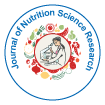Nutrition Across the Lifespan: Meeting Changing Needs
Received: 01-Jan-2025 / Manuscript No. snt-25-168719 / Editor assigned: 04-Jan-2025 / PreQC No. snt-25-168719(PQ) / Reviewed: 18-Jan-2025 / QC No. snt-25-168719 / Revised: 22-Jan-2025 / Manuscript No. snt-25-168719(R) / Published Date: 29-Jan-2025 QI No. / snt-25-168719
Introduction
Nutritional requirements vary significantly throughout the human lifespan, reflecting changes in growth, development, metabolism, and health status. From infancy through old age, adequate nutrition supports physical and cognitive development, immune function, and disease prevention. This article explores how nutritional needs evolve across different life stages and highlights strategies to meet these needs for optimal health [1-4].
Nutrition in Infancy and Childhood
Infancy is characterized by rapid growth and development, necessitating nutrient-dense feeding. Breast milk provides an ideal balance of macronutrients, vitamins, minerals, and bioactive compounds essential for immune protection and brain development. For infants who cannot breastfeed, fortified formulas serve as alternatives.
As children grow, balanced diets rich in fruits, vegetables, whole grains, protein, and healthy fats support physical growth and cognitive development. Adequate intake of iron, calcium, vitamin D, and essential fatty acids is critical to prevent deficiencies that may impair development.
Nutrition education and fostering healthy eating habits early in life set the foundation for lifelong wellness.
Nutrition in Adolescence
Adolescence involves accelerated growth, hormonal changes, and increased nutrient needs. Caloric and protein requirements rise to support growth spurts, muscle development, and sexual maturation.
Iron demands increase, particularly in adolescent girls due to menstruation. Calcium and vitamin D remain important for bone mineralization. Balanced diets rich in whole foods help meet these increased demands.
Adolescents are also vulnerable to poor dietary choices influenced by peers and media, emphasizing the need for nutrition education and access to healthy foods [5].
Adult Nutrition and Maintenance
In adulthood, nutrition focuses on maintaining health, energy balance, and preventing chronic diseases. Caloric needs stabilize but depend on activity levels and metabolic rate.
A diet rich in plant-based foods, lean proteins, whole grains, and healthy fats supports cardiovascular health, weight management, and metabolic function. Adequate fibre intake promotes digestive health, while antioxidants and phytochemicals protect against oxidative stress.
Adults should monitor micronutrient intake, particularly calcium and vitamin D, to prevent bone loss, and maintain iron status, especially in women of reproductive age [6, 7].
Nutrition in Older Adults
Aging brings physiological changes such as decreased metabolism, reduced muscle mass, and altered nutrient absorption, necessitating adjustments in diet.
Older adults require nutrient-dense foods with adequate protein to preserve muscle mass and function. Vitamins B12, D, calcium, and antioxidants are particularly important to counteract age-related deficiencies.
Hydration is also critical, as thirst sensation diminishes with age. Managing chronic conditions through tailored nutrition and addressing appetite changes or dental issues are important aspects of elder care [8-10].
Conclusion
Nutrition must be adapted to meet the dynamic needs across life stages, from supporting growth and development in youth to maintaining health and preventing disease in adulthood and older age. Awareness of these changing requirements and proactive dietary planning can promote longevity and quality of life. Emphasizing nutrient-rich foods, personalized approaches, and education are key strategies to optimize nutrition throughout the lifespan.
Citation: Citation: Guille C (2025) Nutrition Across the Lifespan: Meeting Changing Needs. J Nutr Sci Res 9: 296.
Copyright: © 2025 Guille C. This is an open-access article distributed under the terms of the Creative Commons Attribution License, which permits unrestricted use, distribution, and reproduction in any medium, provided the original author and source are credited.
Select your language of interest to view the total content in your interested language
Share This Article
Open Access Journals
Article Usage
- Total views: 322
- [From(publication date): 0-0 - Dec 10, 2025]
- Breakdown by view type
- HTML page views: 252
- PDF downloads: 70
